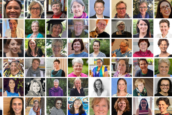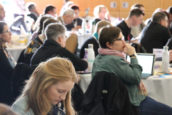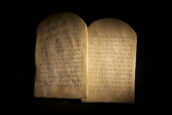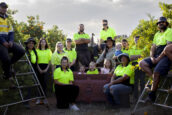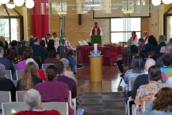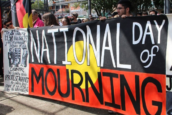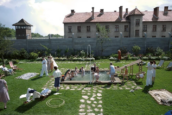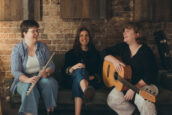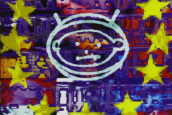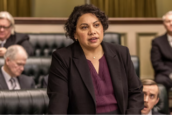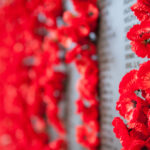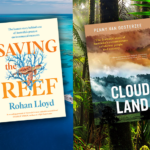
Creative Writing as a Spiritual Practice
Creative writing has long been a useful tool for human beings as we try to better understand our relationship with God. The practice enables us to delve deeper into what we believe, find fresh expressions for our faith, and share these with our wider community. Poetry is a tool of prophets as they demand justice; shared metaphors bind communities together; and creative writing allows us to engage more personally and pastorally with our faith than is possible through academic or theological writing.
We could consider the Bible in this way: as a collection of creative texts of a variety of genres, written by many different people in different languages, united by their purpose of pointing the people of God toward God.
We understand our relationship with God, Jesus, and the Holy Spirit through story: stories that imagine how the world was created using stirring metaphor, stories about a group of people who strayed from and returned to their God over and over again, stories that proclaim freedom for the oppressed, and stories that illustrate a love so selfless it must lead to the cross.
Jesus himself taught through story. His parables contain rich layers of meaning that cannot be conveyed in any other way but through narrative. Not weighed down by scholarly jargon, the parables were accessible to his largely uneducated followers, using images from their own lives, and they continue to challenge the church today.
Over two thousand years, Christian writers have attempted to comprehend their faith and the faith of their communities in the context of their own time and place. The result is a literary tradition rich with story, metaphor, and theology, as writers make the Bible their own. Old stories are made new by fresh expressions which draw on different concepts, cultures, and lived experiences.
Hildegard von Bingen wrote poetry in praise of a Creator God. C.S. Lewis carved fantastical worlds in heaven’s image. Rachel Held Evans used story to invite her readers into the Biblical text. Rev. Dr Wil Gafney’s Midrashic techniques fill the gaps where women are omitted from Bible narratives. Our understandings of God and how we relate to God are shaped by many of these creative expressions. What if we were to participate in the act of creating, ourselves?
Creative writing is, for me, a deeply spiritual practice. I create because I am made in the image of a Creator God, because I am compelled to make sense of the world in this way. When I pick up a pen to write about my faith, I enter into a long tradition of Christian creativity. When I am free of my inner critic and truly able to engage with my faith through imagery and metaphor, the Spirit works through me.
Sometimes after an evocative sermon or challenging Bible study, writing a poem is the best way to wrestle with what I have learned. I am often transformed by this process. As I find new metaphors to understand the events of Good Friday or the complex power dynamics between Hagar, Sarah, and Abraham in Genesis, my own thinking shifts. Writing means inviting the Spirit into my creative process and allowing Her to transform me through my own words on the page.
Sharing these words with others sparks deep conversations, and can complement the liturgy in a church service. This is an accessible way to explore theological concepts, through story, imagery, and metaphor. Because of the many layers of meaning that can be drawn from narrative and poetry, each reader or listener will find different elements that resonate with them.
I recently had the privilege of facilitating workshops for the wonderful people of Christian Students Uniting, a four-part series titled Creative Writing as a Spiritual Practice. My aim was to equip our students with the creative tools to tell their own faith stories in a supportive environment. During such a formative time as university, young adults in the church are widening our horizons and figuring out what we believe, and creative writing is an invaluable practice as part of this process.
Across the four workshops, we participated together in a variety of writing activities. Some prompts invited our writers to bring their whole selves to the page for a weekly check in, others encouraged them to experiment with different forms – from odes to recipes to borrowing the volta of a sonnet – while other activities asked them to engage with different faith concepts in creative ways.
These creative writing workshops were an incredibly rewarding experience. Our cohort was a mix of experienced writers and people who had lost their creative relationship with the page since high school. I watched students blossom from disbelief in their ability to write creatively, to confidently reading their own poems to the class in our final session; from grappling with creative block to fully participating in the communal ritual of writing together. Many reflected that the writing activities opened up for them something about their faith that they had not interrogated before.
Participant Mikali Anagnostis described the workshops as “a safe space where I learned to turn off my inner critic and explore writing without judgement from other people or myself. It was a valuable experience and I’m definitely going to incorporate a lot of what I learned into my creative and spiritual practice.”
Hannah Roux found that “the process of working on and developing different pieces of writing on related spiritual topics was one I found clarifying and useful – in the spiritual as well as in the artistic sense… One of the things I liked best about these workshops was the context of writing in, for and with a particular group of people about our shared faith and spiritual experience. This helped bring things to the surface for me that I might not have noticed otherwise, and I was able to engage with those topics in a deeper, more considered way.”
The “biggest impact” of the workshops for Clare Pryor “was that they provided the opportunity for healthy introspection through creativity. It had been a while since I took the time regularly each week to get back in touch with myself.”
These workshops were a creative and pastoral ministry. Baring your your faith on the page is a transformative experience, and I hope that those who participated feel empowered to continue using these creative tools. Engaging with creative writing as a communal practice also invites writers to connect with each other on a deeper level, as we are each touched by the other’s writing. The vulnerability of sharing a poem or a story with the group bound those of us in the workshops together, like a sermon drawn from the preacher’s life experience.
I was moved by the below prose poem, written by Hannah Roux, Secretary of Christian Students Uniting at the University of Sydney, a participant in our creative writing workshops who is currently undertaking a PhD in English Literature.
Time of the Month by Hannah Roux
At That Time of the Month, I get back pain and often want to lie flat, looking upside-down at the world. I sometimes feel, then, that something strange is moving, in my belly and through me. Something not-me is in me, and my body is writhing under skin. There’s not much I can do about this.
Sometimes I lie on the floor, and my eyes drink in the ceiling. All the world is pressing into my skin and I can feel the sky breathing. Then everything but me is moving, and something is moving in me, and all the world’s pressed in, like fizzy lightning. Eyes closed, I can see everything. Or maybe everything is a felt thing.
At times, it feels like my body is doing things without me. Having its own adventures, keeping its own time. Paul calls the church a body. Sometimes I think this is why. My body does things without my permission – even though my body is me.
Sometimes I find it hard to trust that my body knows what it’s doing. Especially when I’m bleeding, and it feels like my flesh is wriggling. The body doesn’t always know what it’s doing. It seizes up, gets sick, grows frail, is not in my control.
God is another thing I cannot control. But I try to remember: God, too, had a body that bled.
Bringing faith and creative writing together can bear many different kinds of fruit: from hearing a friend articulate something you have felt but never found the words for, to reimagining prayers in a liturgy for the Season of Creation, to encouraging more lay participation in church services.
Sermons are not reserved for ordained ministers who preach from pulpits. A sermon can be a picture book read to children, a poem that commands a congregation’s attention, a letter to a friend, a novel that allows you to escape into a new world and return changed to our own, a song performed by a singer with tears in their eyes, a community play full of laughter, a meditative chant that we repeat until the words are part of us.
Words carry power, and using them to express our experiences of faith, of justice, and of community empowers us. We know ourselves and our God better when we articulate what we believe through metaphor, imagery, and story. Through the act of creating, God re-creates us in Their own image, over and over again. I encourage you to pick up a pen and invite the Holy Spirit onto the page.
Gabrielle Cadenhead is a mission worker for Christian Students Uniting at the University of Sydney
- Categories: Belief Matters, Features








